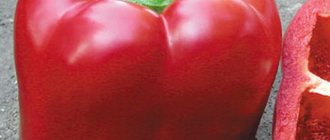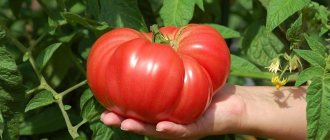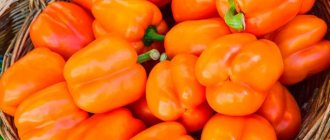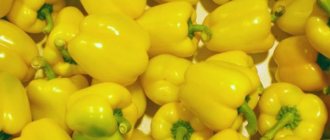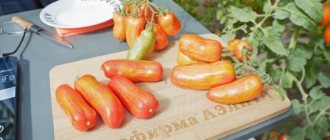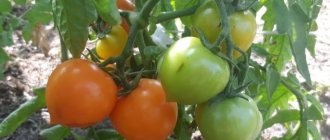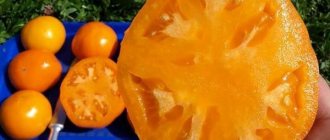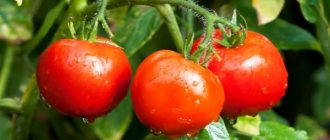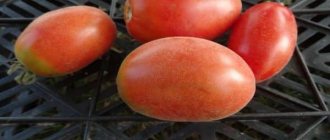The “Red Bison” pepper variety is classified as a sweet variety of vegetable, which is distinguished by its high taste and large amount of useful substances. So, in terms of vitamin C content, pepper is ahead of lemon, and the amount of vitamin A in it is higher than carrots.
The name Bison accurately emphasizes the large size of the fruits of this variety of pepper. However, novice and professional gardeners appreciate this variety for other reasons. Therefore, it is worth considering the characteristics and description of red Bison pepper, its photo and agricultural technology.
Characteristics of the red bison variety
Being an early ripening variety, red bison is suitable for cultivation in different regions of Russia. However, it feels good outdoors only in southern climate zones. For more northern latitudes, only greenhouse conditions are recommended.
The plant itself is large in size. The height of an adult bush can reach 90 cm. It produces fruits up to 25 cm in length.
Advice. To avoid damage to the plant under the weight of the future harvest, a garter is included in the care of representatives of this variety.
During the ripening process, pepper fruits are green in color, and when they reach biological maturity they are colored deep red. Their shape looks like an oblong cone with deep folds. The wall thickness of 4-5 mm ensures the fruits are fleshy and juicy.
Growing and care
In the southern territories (Crimea, Kuban), peppers are planted directly in open soil. In northern latitudes (Altai, Siberia), it is advisable to carry out cultivation in closed beds.
Seedlings are transplanted at the age of 60-70 days.
What rules are followed when cultivating peppers:
- water systematically at the rate of 1-1.5 liters for young bushes, 4-5 liters for plants at the ripening stage (the frequency of moisture is determined by the weather);
- remove the lower leaves, form into 2 trunks, starting from the level of the fork;
- tied to supports or posts;
- the surface is loosened, the lower part of the stem is hilled;
- organic and mineral compounds are introduced (the supply of nitrogen and phosphorus-potassium fertilizers is mandatory).
Complex preparations are used for active flowering and fruiting - Lifdrip, Humisol, Ideal, Agronom Profi, Fertika Lux.
Advantages of the variety
The Red Bison variety has received high marks among breeders and gardeners for a number of qualities:
- early fruit ripening, up to 110 days;
- high productivity;
- the possibility of growing in a greenhouse or in open ground, depending on the climate zone;
- relative ease of care;
- the weight of ripened fruits can reach 200 g;
- protection from infections.
In cooking, the fruits of this pepper variety are considered universal. They can be part of any summer salad, adding their own unique taste to the combination of vegetables. Pepper fruits are also suitable for heat treatment, which allows them to be used in stuffing and preparing fried, stewed dishes, as well as canned preparations.
Description of fruits
- The fruits of the “Red Buffalo” are very large and weighty - the length of individual record holders can exceed 25 cm and weight - 250 g. On average, peppers of this variety grow to 15-16 cm and gain weight 170 +/- 20 g.
- The walls of the Bison fruit are not as massive as those of most hybrids - their average thickness does not exceed 5 mm, but this relative disadvantage is compensated by an excellent, noticeably sweet taste, pronounced aroma, as well as the special tenderness of the pulp and the skin covering it.
- At the stage of technical ripeness, peppers are colored green. Fully ripened fruits are glossy, dark red, very elegant.
- The shape of Red Buffalo peppers is conical, elongated, with deep vertical folds.
- The fruits of this variety are well stored and can be transported quite easily.
Pepper seedlings
Preparing and sowing seeds
As is the case with other pepper seeds, preference is given to growing through seedlings. The first stage of work involves preparing the land and checking the material for planting.
It is worth remembering that pepper is a rather demanding crop when it comes to soil. Heavy soil types with large amounts of clay or loam can negatively affect its development and productivity. Therefore, soil from the garden must be mixed with fertilizer before use, and, if necessary, lightened by adding sand.
Important. Although the Bison red pepper variety is vaccinated against infections that are common for this crop, it does not hurt to additionally disinfect it in a manganese solution.
Checking seeds is the key to greater germination and reduced time for seedlings. There are two methods for identifying material unsuitable for sowing:
- The seeds need to be placed in a saline solution for 20 minutes. What ends up at the bottom after the expiration date can be used for seedlings.
- The second method involves placing future plants between two gauze, which must be kept moist for 2-3 days. After this, you should choose the seeds that have hatched for planting.
Immediately before planting, the planting material must be placed in a growth stimulator for approximately 11 hours.
To get seedlings by the end of spring or beginning of June, you need to start working in February. The prepared container is filled with earth. After the soil has been sufficiently moistened, grooves 1 cm deep are made in it, where the seeds are placed. The distance between the grooves reaches 5-7 centimeters, and between the seeds from 2 cm. At the end of the process, they need to be covered.
For reference. In order not to create obstacles for seed germination, you should not place them too deep in the bud.
To ensure better germination, it makes sense to cover the soil with film. It is advisable to check the container every day.
This will help to detect the lack of moisture in time and replenish it, as well as determine the time to remove the film so that young, tender shoots do not burn.
Advantages and disadvantages
For most amateur gardeners, red bison pepper from the Gavrish company, according to reviews, has become a real find, thanks to its high yield.
Its other advantages are also noted:
- Early ripening and long fruiting throughout the summer.
- Pleasant taste and aroma of large fruits.
- Versatility of use.
The disadvantages of this variety for fans of thick-walled varieties include the small wall thickness (up to 5mm).
Seedling care
For the next 2-3 months, the seedlings require care at home. It includes:
- watering;
- loosening;
- feeding;
- picking;
- hardening.
At the seedling stage and after planting in the ground, it is worth remembering that pepper does not tolerate drought, but also does not like excessive watering.
Therefore, the supply of moisture should be provided in small portions and regularly. And after each watering, be sure to loosen the soil so that the plant roots receive enough air. But this should be done carefully so as not to damage the fragile root system.
Important. The water temperature for irrigation is +28-30 degrees. Using a colder liquid can slow down the growth and development of seedlings.
To ensure healthy and strong seedlings, it is necessary to create the correct temperature and light conditions. It assumes +24-25 degrees and a sufficient amount of light. The last condition is achieved by placing the container with seedlings on the window. But if such a decision threatens the temperature regime, it makes sense to temporarily replace natural lighting with artificial lighting.
You may be interested in: Favorable days for planting pepper for seedlings in 2021: terms and rules for sowing at home Favorable days for picking pepper in 2021 according to the lunar calendar Favorable days for sowing sweet and bitter pepper for seedlings in 2021
Feeding is required 2-3 times during this period. For this you can use natural or chemical fertilizers.
It is also worth introducing them into the soil in small doses at intervals of at least two weeks. The third fertilizing is not considered mandatory; it can be applied immediately before planting in the ground.
As soon as 2-3 shoots appear on the stems of the seedlings, it’s time to start picking. To do this, you should stock up on cups in advance for the number of plants.
Note. At this stage, it is already possible to identify weak or painful shoots that can be removed.
In the process of extracting sprouts from the ground and separating them from each other, you must be extremely careful. Any damage to the roots will negatively affect their health in the future. When planting in the ground, you do not need to deepen the shoot too much. The ideal option would be to place it in the ground at the same level as before.
A few days before planting in the ground, you can begin hardening the seedlings. This procedure will help the plants adapt better after being placed in the garden bed. Containers with seedlings are placed outside every day for several hours. Mandatory conditions here will be an outside air temperature of at least 15 degrees and the absence of strong wind.
Features of cultivation
When growing peppers, the stage of preparing seedlings, which many gardeners prepare themselves, is important.
May be interesting Cucumbers “Crispina f1”: recommendations for growing “Abundant”: description of the variety and secrets of cultivation Pepper “Bogatyr”: friendly fruit yield is guaranteed
To get nutritious, light and breathable soil that peppers love, mix turf or garden soil with humus and ash.
If necessary, add peat or sand. To disinfect, you can heat the soil in the oven or soak it with a solution of potassium permarganate.
Seeds before sowing are also treated:
- Disinfect with phytosporin or other means (for example, Maxim summer resident). According to reviews, treating seeds with garlic juice gives good results.
- Growth stimulants or a solution of microelements. Natural honey or aloe juice can be used as a natural growth stimulator.
- Soak in a damp cloth at a temperature of 25-28 degrees. to speed up germination (usually 5-8 days).
The container for growing seedlings should be shallow, with drainage holes to allow excess moisture to drain out.
Germinated seeds are sown in boxes to a depth of approximately 10 mm, at intervals of 2-3 cm, covered, and kept at a temperature of 23-25 degrees until germination.
Emerging seedlings need maximum illumination for at least 12 hours a day, for which artificial lighting is sometimes used.
Landing in the ground
Depending on further conditions, the timing of planting seedlings in the ground is determined:
- May 10-20 for the greenhouse;
- May 20-30 for open ground.
A more precise time is determined by the gardener depending on specific weather conditions. The optimal condition for this process is cloudy weather with a temperature of + 18 degrees.
Before planting, prepare a bed with holes up to half a meter deep and at a distance of approximately 45 cm from each other. The seedlings are removed from the cups, preferably with soil, to avoid unnecessary discomfort to the roots. Fertilizer is placed at the bottom of the hole and partially covered with soil. It is necessary to completely cover the hole with soil after placing the plant in it. As with picking, you should avoid excessively deepening the seedling. This will allow it to take root better and establish itself naturally.
Variety "Red Buffalo" - bell pepper with excellent characteristics
High productivity and excellent marketable quality of the fruit distinguish the Red Bison sweet pepper from other varieties of bell pepper widely offered by domestic seed companies. Photos of pepper, descriptions and characteristics of varietal characteristics, as well as reviews from gardeners about its cultivation will allow you to understand the advantages and disadvantages of the “Red Bison”.
Characteristics of the variety and conditions of agricultural technology
Pepper "Red Buffalo" is a highly productive vitamin variety with an early ripening period. The cultivation method is universal, in the southern regions - in open ground, and in temperate and northern regions - in greenhouses. Regardless of the chosen growing method, technical ripeness of the fruit occurs 94-105 days after emergence.
Tall pepper bushes, when grown in open ground, can reach 70 cm, and in a greenhouse - 90 cm. Powerful bushes with thick stems, densely covered with foliage.
Plants practically do not require shaping and tying to supports. The exception is pepper grown in a greenhouse, since due to overload of fruits, they can break under their own weight.
Attention! “Red Bison” is a high-yielding variety that, subject to agrotechnical conditions, can produce up to 10 kg of high-quality fruit. Duration of fruiting is long, persists until frost
"Red Bison" is a large-fruited variety. Its cone-shaped peppers, growing, reach an average of about 16 cm in length and a weight of 200 g. The thickness of the fleshy walls is 0.4-0.5 cm. The size of individual fruits is very impressive - amounting to 25 cm in length and 250 g of weight.
Product characteristics of the fruit:
- taste – sweet, juicy, tender, has good crunchiness;
- aroma – characteristic, pronounced;
- color – bright, glossy. Fruits that have reached technical ripeness are colored green, those that have reached biological ripeness are dark red;
- keeping quality is high, fruits can remain fresh for a long time;
- transportability – excellent;
- use – universal: fresh and processed.
Basically, the technology for growing “Red Buffalo” is no different from other varieties of pepper and consists of the following steps:
- Early sowing of seeds for seedlings - at the end of winter.
- Picking peppers into separate containers in the cotyledon leaf stage.
- Planting in a permanent place - May-June, following the scheme - 40x80 cm
- If it is necessary to carry out shaping, it is recommended to remove all leaves and lateral shoots from the bushes below the first branching.
- Gradual harvesting of fruits is carried out in the technical ripeness phase, on average 100 +/- 5 days after emergence.
Reviews of "Red Buffalo"
Maria, Moscow region. “This summer I tried to grow Red Bison. I planted seedlings at the end of winter, 1-2 seeds for each peat tablet. They sprouted well and developed well. For the sake of the purity of the experiment, I planted part of the seedlings in a greenhouse in May, and the second part in the ground under a film cover. From the second half of June, the shelter was completely removed. Watered, weeded, fed. As a result, large and sweet fruits grew in the greenhouse, as stated on the package of seeds. We collected quite a lot of well-ripened peppers - a little more than 20 kg, despite the fact that my greenhouse is small. In the open beds, peppers had to be removed earlier due to the threat of early frosts. But both fruits turned out tasty and sweet. I will plant more, but only in the greenhouse.”
Pavel Vasilievich, Krasnodar. “The impression about the variety is only positive. “Red Bison” has no defects, it sprouts and grows well and bears fruit, it does not require care, as usual. As a result, bushes grew up to a height of more than 0.5 m, all strewn with peppers. Just in case, each bush was tied to a support - there were so many ovaries. Peppers were collected until the end of September, used both for seaming and fresh, there was even something to offer for sale.”
Evgenia Ivanovna, Lipetsk. “This variety pleased me with its productivity, beautiful appearance and excellent taste. I like that the peppers do not ripen all at once, but gradually, which allows you to enjoy juicy, vitamin-rich vegetables for several months in a row. Undemanding and early ripening, grows well in a greenhouse under film. Next year, along with the Red Bison, we will plant the Yellow Bison.”
As reviews and varietal characteristics show, Red Buffalo pepper is an excellent choice for cultivation in the ground, greenhouse and greenhouse. An early-ripening variety, with a good yield of fruits that have excellent commercial qualities, can please both experienced and novice gardeners.
Basics of proper pepper care
The first concern of the gardener is to protect the seedlings from possible frosts. To do this, arcs are installed and covered with film. Additionally, the area around the roots can be covered with newspaper or a layer of grass. Another way to protect against freezing involves using plastic bottles with the bottom cut off. While the sprouts are still small, they can be covered entirely in this way, opening the lid during the day for ventilation.
Further care includes all those actions that were required in the process of growing seedlings: watering, weeding, loosening, fertilizing. Here it is worth paying attention to maintaining soil moisture without overwatering.
Important. A feature of the Bison red pepper variety is the need to tie up the bushes. This is done simultaneously with planting in the ground. A support is dug in parallel with the plant, to which it is fixed.
There are different opinions about what form it should be harvested in. Some people prefer to let the fruits reach biological maturity on the branch, so they take their time picking them. And if this approach is appropriate in the southern climatic zones, then in the northern regions it makes sense to harvest a technically mature harvest.
Firstly, it will be able to gain color during storage. Secondly, for fruits that appeared on the branches later, it will be possible to reach maturity faster.
Sweet pepper Bison red
Taking care of every client!
Fast, comfortable and inexpensive!
It’s very easy to get lost in such a large assortment of all kinds of products, and of course you want so many things! But it happens that it is not possible to order everything at once.
So that you don’t lose the products you like and don’t waste time searching for them, we have created a convenient section for you where you can save the items you like.
Now you can create your own “Family Garden”.
To get started, use the already created “Favorites” list and save all the items you like to it. If you want to create a list with your own name, just click the “Add new list” button. Give it any name that will help you navigate, for example “Seeds for 2021”, “My Club”, “Summer Flowerbed”, etc. And when the time comes, in a few clicks order all the necessary goods, for example, for your winter garden.
Now viewing the detailed description of the product, you can click the “Add to My Family Garden” button, and the product you like will be saved in the folder of your choice.
Easy, fast, convenient! Happy shopping!
To add a product to My Family Garden, you must go to the product page.
My Family Garden On the section page you can view all the products you have added, as well as the lists you have created.
From here you can add items to your cart individually:
And also the whole list:
You can also remove a product from the selected list:
Or clear the entire list of products:
To completely delete the list, use the following link:
Create lists on various topics. Examples of names can be very different: “My future summer flowerbed”, “For the dacha”, “Apple orchard” and many others. Do you know exactly what fruit and berry seedlings you will order? So call the list “Delicious”, adding your favorite varieties there. And when the time comes, order the entire list in just a few steps.
We have done everything to make My Family Garden as convenient and easy to use as possible!
Protecting peppers from diseases
In some cases, the cause of crop loss may be a disease of seedlings or already mature bushes. Here are some common problems that peppers can suffer from:
- Black leg in seedlings can be a result of poor-quality soil, excess moisture or drafts. If the problem is contaminated soil, it must be disposed of. If the soil in a greenhouse is contaminated, a layer up to 7 cm deep is removed for this purpose, and then disinfected with a sulfur bomb or bleach. Prevention of the disease is moderate watering with warm water and protection from drafts.
- Late blight can develop in the second half of summer, manifesting itself in blackening of fruits. Disinfecting seeds in potassium permanganate will help protect the crop from this disease. During the period of intensification of the disease, it is recommended to cover the beds with pepper with film or other moisture-proof material. Spraying is widely used. An infusion of onion peels can be used as a natural remedy, but chemical analogues can also be used.
- Black bacterial spot can develop in plant debris that has not been removed since last season. Therefore, the best prevention would be to clean and burn dried vegetable bushes. For reference: tomatoes and peppers have common diseases. Therefore, these crops are planted as far apart as possible.
In which regions are Red Bison peppers grown?
Pepper of this variety is suitable for growing in all regions of Russia, but with some exceptions. Southern regions can plant peppers in open ground from late spring to early summer, while northern regions need a greenhouse to obtain a harvest, since even in the summer the earth does not warm up enough, and in a greenhouse the most comfortable and favorable conditions can be created.
By following simple recommendations and tips for growing, in just a few months you will be able to get a large and high-quality harvest of Bison Red pepper, which will appeal to both a novice gardener and any housewife.
